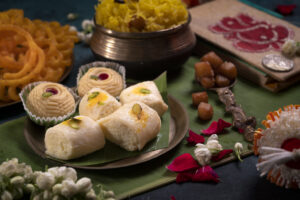Authentic Indian Samosa Recipe – A Traditional Snack
Cuisine: Indian
Samosa, a beloved Indian snack, is perfect for any occasion with its flaky pastry and spicy filling. Traditionally enjoyed as a street food staple or during festive gatherings, this dish is not only delightful in flavor but rich in history and culture. Originating from India, samosas have found their place in countless varieties across the globe, from the crispy potato-filled versions of North India to the spiced lentil samosas popular in southern regions.
Table of Contents
ToggleIn this recipe, we will be preparing classic vegetable samosas, but there are many variations to explore. From meat-filled samosas to the sweet versions often made during festivals, each variation offers a unique taste and texture. However, our focus here is on creating the perfect golden-brown samosa that is a treat for the senses and a must-try for any food enthusiast.
Ingredients for Samosa
| All-purpose flour | 2 cups |
| Potatoes (boiled & mashed) | 2 medium |
| Green peas (boiled) | 1/2 cup |
| Cumin seeds | 1 tsp |
| Garam masala | 1 tsp |
| Chili powder | 1/2 tsp |
| Salt | to taste |
| Oil | for frying |
Preparation Method
Creating the perfect samosas requires patience and the right technique. Follow these steps for a delicious result.
- In a mixing bowl, combine the all-purpose flour and salt. Gradually add water and knead into a stiff dough. Allow it to rest for 30 minutes.
- In another bowl, mix the mashed potatoes, boiled peas, cumin seeds, garam masala, chili powder, and salt to make the filling.
- Divide the dough into equal parts and roll out each part into a circle of about 6 inches diameter.
- Cut each circle in half to form two semi-circles. Take one semi-circle, shape it into a cone, and seal the edges by moistening them with water.
- Fill the cone with the potato filling and seal the open edge to form a triangular shape.
- Heat oil in a deep frying pan over medium heat. Once hot, fry the samosas until golden brown and crispy.
- Remove from oil and place on a paper towel to drain excess oil. Serve hot with chutney or sauce.
Nutritional Values
| Nutrient | Value per serving |
|---|---|
| Calories | 250 |
| Protein | 6g |
| Fat | 12g |
| Carbohydrates | 30g |
| Fiber | 3g |
Serving Suggestions
These samosas are ideal for a variety of occasions. Whether it’s for a children’s tiffin, an appetizer at a party, or a delightful treat during family gatherings, they never fail to impress. Kids especially enjoy them as a snack or in their lunchboxes, making it a perfect choice for school. For adults, they serve as a wonderful starter or a complement to evening tea. The versatility of samosas allows them to transition smoothly from casual snacking to elegant appetizers.
Cultural Background and Story of Samosa
The samosa is not just a snack; it carries a rich tapestry of cultural significance woven through the fairs and festivals of India. Traditionally enjoyed during Diwali, Eid, and other special occasions, samosas represent a spirit of togetherness and hospitality. Families often gather in the kitchen to prepare samosas, sharing laughter and stories, which adds to the flavor of this cherished dish.
If you’re considering starting a business centered around samosas, there are opportunities and challenges to weigh. The appeal of samosas as street food is immense, with many enjoying them during their daily commutes or as a part of a meal. While established brands may dominate the market, niche offerings such as organic or fusion samosas can cater to evolving consumer tastes. Additionally, promoting samosas as a healthy snack option could tap into the growing demand for healthier foods.
However, like any venture, there are challenges. The competition is fierce, and maintaining the authenticity and quality of ingredients is crucial to stand out. Nonetheless, with the right marketing strategy and a unique product offering, a samosa brand could certainly thrive.




